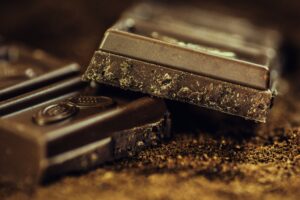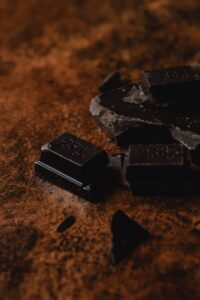Quality Parameters of Chocolate
When someone says, “a golden ticket,” most people -especially those having a childhood in the 70’s- will think of the chocolate due to the Willy Wonka & the Chocolate Factory. Making a connection between the chocolate and the golden ticket was not a nice coincidence in this book since chocolate, particularly its main ingredient, cacao, has been an important item in myths and known as the drink of the gods for centuries (Gasco, 2009; Heinrich, 2009). Chocolate, the sign of wealth and power in ancient times, has been consumed for different purposes. In the Aztec empire, it was looked at as a symbol of political power, while in the Late Classic Maya Period, it was offered in marriage arrangements and funeral rituals (Henderson et al., 2007; LeCount, 2001). Today, it is one of the most desired snacks in the world with its many different varieties. Although there are three main types of chocolate: milk chocolate, dark chocolate, and white chocolate, chocolate types are increased by adding new flavors or producing new types of the chocolate day by day. Chocolate is not only the most wanted snack but also it is beneficial for health and improves mood. Chocolate consumption affects cardiovascular health in a good way and changes the abundance of some kinds of bacteria in gut microbiota, resulting in a significantly reduced negative mood (Garcia et al., 2018; Shin et al., 2021). Besides the history and the benefits of chocolate, the quality of chocolate is also an essential issue for chocolate manufacturers and consumers.
says, “a golden ticket,” most people -especially those having a childhood in the 70’s- will think of the chocolate due to the Willy Wonka & the Chocolate Factory. Making a connection between the chocolate and the golden ticket was not a nice coincidence in this book since chocolate, particularly its main ingredient, cacao, has been an important item in myths and known as the drink of the gods for centuries (Gasco, 2009; Heinrich, 2009). Chocolate, the sign of wealth and power in ancient times, has been consumed for different purposes. In the Aztec empire, it was looked at as a symbol of political power, while in the Late Classic Maya Period, it was offered in marriage arrangements and funeral rituals (Henderson et al., 2007; LeCount, 2001). Today, it is one of the most desired snacks in the world with its many different varieties. Although there are three main types of chocolate: milk chocolate, dark chocolate, and white chocolate, chocolate types are increased by adding new flavors or producing new types of the chocolate day by day. Chocolate is not only the most wanted snack but also it is beneficial for health and improves mood. Chocolate consumption affects cardiovascular health in a good way and changes the abundance of some kinds of bacteria in gut microbiota, resulting in a significantly reduced negative mood (Garcia et al., 2018; Shin et al., 2021). Besides the history and the benefits of chocolate, the quality of chocolate is also an essential issue for chocolate manufacturers and consumers.
There is an increasing tendency to consume high-quality foods because of market pressure and health and environmental concerns (Petrescu et al., 2020). Consumer preference about food choice mostly depends on the food quality. Their intention is mainly related to their subjective judgments using one or more of the five senses to select or eat any food (Vaclavik et al., 2007). When it comes to chocolate, the factors that play a role in determining the quality are more complex than just using the five senses. The story of the quality chocolate begins with its cocoa tree, is followed by harvest season, and then ends with processing steps. Besides the importance of these successive parts in themselves, microbiological quality parameters are also critical.
Chocolate is a quietly complex multiphase system (El-kalyoubi et al., 2011). It is a semisolid suspension consisting of solid particles, sugar, cocoa, and particular milk components and the continuous phases, cocoa butter, milk fat, and emulsifiers. (El-kalyoubi et al., 2011; Gunaratne et al., 2019). The main ingredient of the chocolate is cacao, and the original homeland of the cacao tree, Theobroma cacao L., is in South and Central America; however, there has been cocoa production on a broader scale area in the world (Caligiani et al., 2015; Del Prete et al., 2020). Although the main ingredient is cacao, the type or geography is not the primary quality parameter for chocolate. Chocolate is a highly processed food, and so it can be produced and consumed in a different part from its raw materials, cacao. This situation display that the most important quality parameter is its manufacturing processes, and it can be show varieties according to national consumer preferences and company practices (Afoakwa et al., 2007; Cidell et al., 2006).
The raw chocolate beans have an undesired and astringent taste that consumers are unfamiliar within chocolate. Fermentation, drying, and roasting are significant steps to obtain the characteristic chocolate taste (Boyd, 2018). The fermentation process is the primary process for the creation of aroma characteristics of the chocolate. The story of the flavor and the color formation starts in beans before the manufacturing processes. The microbiological aspect of chocolate production is mainly related to the fermentation step. Fermenting the cocoa beans is an essential step in post-harvesting, and it is one of the critical processes that dominate the quality of the final product (Boyd, 2018). While enzymatic and microbial fermentation after harvest prompt physical and chemical change to develop color, sun drying creates more favored flavor formation(Afoakwa et al., 2007).
After fermentation and drying, roasting is the other important step related to the chocolate’s quality and the flavor components. During the roasting, the Maillard reaction occurs, and flavor-active aldehydes are produced. Also, some volatile compounds made in the fermentation step are removed to balance the astringency and taste(Afoakwa et al., 2007).
 Particle size, essential for the texture of chocolate, and viscosity are being determined through refining and conching steps (El-kalyoubi et al., 2011; Gunaratne et al., 2019). The particle size and their distribution influence chocolate’s rheological properties, such as how spreadable and creamy the chocolate is. Concerning the viscosity, the degree of fluidity is crucial as it affects the mouthfeel of the product. On the other hand, particle size optimization improves process control by decreasing the necessity for a viscosity modifier (El-kalyoubi et al., 2011).
Particle size, essential for the texture of chocolate, and viscosity are being determined through refining and conching steps (El-kalyoubi et al., 2011; Gunaratne et al., 2019). The particle size and their distribution influence chocolate’s rheological properties, such as how spreadable and creamy the chocolate is. Concerning the viscosity, the degree of fluidity is crucial as it affects the mouthfeel of the product. On the other hand, particle size optimization improves process control by decreasing the necessity for a viscosity modifier (El-kalyoubi et al., 2011).
The most known characteristic of chocolate is its melting behavior. It usually is solid at ambient temperature and rapidly melts when met with oral saliva. Cocoa beans have a high amount of cocoa butter, and triglycerides consist of primarily saturated stearic (34%) and palmitic (27%) fatty acids and monounsaturated oleic (34%) acid (Beckett, 2008). Hence, that characteristic behavior has resulted from the lipid composition of the chocolate (Cidell et al., 2006; El-kalyoubi et al., 2011).
Due to triglyceride composition, cocoa butter can crystallize in several polymorphic forms, and processing conditions determine these forms. There are six polymorphic forms indicated as I-VI with the principal being (Beckett, 2008). In the scope of chocolate quality, having the most convenient polymorphic form is essential. The tempering process serves this purpose. Tempering influences final quality characteristics like color, hardness, and shelf-life. The well-tempered chocolate, in form V, has a good shape, color, gloss, good snap, contraction from the mold, and resistance to bloom (Afoakwa et al., 2007). If chocolate is poorly tempered, the outcome is soft and not effectively demolded.
Several studies have been made in the industry to produce new chocolate types and improve the quality. On the other hand, some chocolate producers market the chocolate flavor with the cocoa bean’s region. This market strategy is very similar to the world-famous big coffee brand; geography is a flavor. However, the story behind the quality that makes us consume chocolate with a great pleasure, which is in every moment of our lives, is bigger than the homeland of the cocoa bean.
CONTENT: Miray ERTÜRK(Department of Food Engineering, METU)
REFERENCES
Afoakwa, E. O., Paterson, A., & Fowler, M. (2007). Factors influencing rheological and textural qualities in chocolate – a review. Trends in Food Science and Technology, 18(6), 290–298. doi: 10.1016/j.tifs.2007.02.002
Beckett, S. (2008). Crystallising the fat in chocolate. In The Science of Chocolate (2nd ed., pp. 85–103). doi: 10.1039/9781847552143-00085
Boyd, H. (2018). Complimentary Contributor Copy. Protests and Riots Past: Present and Future Perspectives, January 2015, 47–75. Retrieved from https://mail.google.com/mail/u/0/?pli=1%5Cnpapers3://publication/uuid/D84FC782-E317-4880-B951-0697213436E1
Caligiani, A., Marseglia, A., & Palla, G. (2015). Cocoa: Production, Chemistry, and Use. In Encyclopedia of Food and Health (1st ed.). Elsevier Ltd. doi: 10.1016/B978-0-12-384947-2.00177-X
Cidell, J. L., & Alberts, H. C. (2006). Constructing quality: The multinational histories of chocolate. Geoforum, 37(6), 999–1007. doi: 10.1016/j.geoforum.2006.02.006
Del Prete, M., & Samoggia, A. (2020). Chocolate consumption and purchasing behaviour review: Research issues and insights for future research. Sustainability (Switzerland), 12(14). doi: 10.3390/su12145586
El-kalyoubi, M., Khallaf, M. F., Abdelrashid, A., & Mostafa, E. M. (2011). Quality characteristics of chocolate – Containing some fat replacer. Annals of Agricultural Sciences, 56(2), 89–96. doi: 10.1016/j.aoas.2011.05.009
Garcia, J. P., Santana, A., Baruqui, D. L., & Suraci, N. (2018). The cardiovascular effects of chocolate. Reviews in Cardiovascular Medicine, 19(4), 123–127. doi: 10.31083/j.rcm.2018.04.3187
Gasco, J. (2009). Soconusco cacao farmers past and present: Continuity and change in an ancient way of life. In Chocolate in Mesoamerica: A Cultural History of Cacao.
Gunaratne, T. M., Viejo, C. G., Gunaratne, N. M., Torrico, D. D., Dunshea, F. R., & Fuentes, S. (2019). Chocolate quality assessment based on chemical fingerprinting using near infra-red and machine learning modeling. Foods, 8(10). doi: 10.3390/foods8100426
Heinrich, M. (2009). Chocolate: Pathway to the Gods. Journal of Ethnopharmacology, 122(2), 416. doi: 10.1016/j.jep.2008.12.028
Henderson, J. S., Joyce, R. A., Hall, G. R., Hurst, W. J., & McGovern, P. E. (2007). Chemical and archaeological evidence for the earliest cacao beverages. Proceedings of the National Academy of Sciences of the United States of America, 104(48), 18937–18940. doi: 10.1073/pnas.0708815104
LeCount, L. J. (2001). Like Water for Chocolate: Feasting and Political Ritual among the Late Classic Maya at Xunantunich, Belize. American Anthropologist, 103(4), 935–953. doi: 10.1525/aa.2001.103.4.935
Petrescu, D. C., Vermeir, I., & Petrescu-Mag, R. M. (2020). Consumer understanding of food quality, healthiness, and environmental impact: A cross-national perspective. International Journal of Environmental Research and Public Health, 17(1). doi: 10.3390/ijerph17010169
Shin, J.-H., Kim, C.-S., Cha, L., Kim, S., Lee, S., Chae, S., Chun, W. Y., & Shin, D.-M. (2021). Consumption of 85% cocoa dark chocolate improves mood in association with gut microbial changes in healthy adults: a randomized controlled trial. The Journal of Nutritional Biochemistry, 108854. doi: 10.1016/j.jnutbio.2021.108854
Vaclavik, V. A., & Christian, E. W. (2007). ESSENTIALS OF FOOD SCIENCE (3rd ed., Vol. 148). Springer.
The information contained in this document reflects only the view of the SuChAQuality project and in no way reflects the European Commission’s opinion for which cannot be held responsible for any use that may be made of the information it contains

